Minjung Kim
Possibility for Proactive Anomaly Detection
Apr 15, 2025Abstract:Time-series anomaly detection, which detects errors and failures in a workflow, is one of the most important topics in real-world applications. The purpose of time-series anomaly detection is to reduce potential damages or losses. However, existing anomaly detection models detect anomalies through the error between the model output and the ground truth (observed) value, which makes them impractical. In this work, we present a \textit{proactive} approach for time-series anomaly detection based on a time-series forecasting model specialized for anomaly detection and a data-driven anomaly detection model. Our proactive approach establishes an anomaly threshold from training data with a data-driven anomaly detection model, and anomalies are subsequently detected by identifying predicted values that exceed the anomaly threshold. In addition, we extensively evaluated the model using four anomaly detection benchmarks and analyzed both predictable and unpredictable anomalies. We attached the source code as supplementary material.
Neural Fourier Modelling: A Highly Compact Approach to Time-Series Analysis
Oct 07, 2024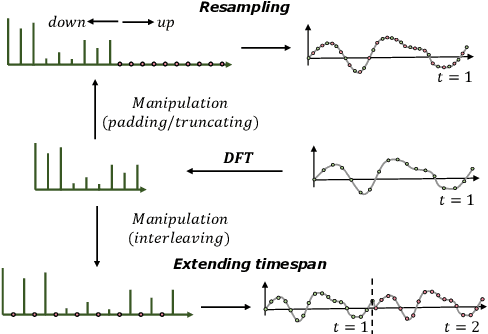

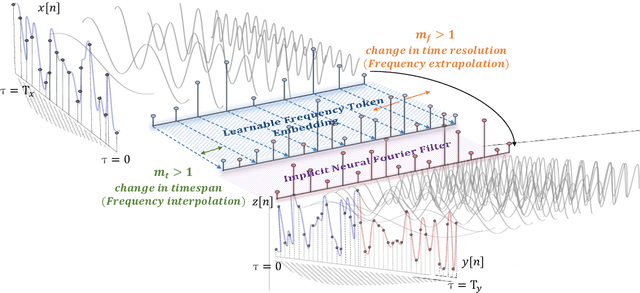

Abstract:Neural time-series analysis has traditionally focused on modeling data in the time domain, often with some approaches incorporating equivalent Fourier domain representations as auxiliary spectral features. In this work, we shift the main focus to frequency representations, modeling time-series data fully and directly in the Fourier domain. We introduce Neural Fourier Modelling (NFM), a compact yet powerful solution for time-series analysis. NFM is grounded in two key properties of the Fourier transform (FT): (i) the ability to model finite-length time series as functions in the Fourier domain, treating them as continuous-time elements in function space, and (ii) the capacity for data manipulation (such as resampling and timespan extension) within the Fourier domain. We reinterpret Fourier-domain data manipulation as frequency extrapolation and interpolation, incorporating this as a core learning mechanism in NFM, applicable across various tasks. To support flexible frequency extension with spectral priors and effective modulation of frequency representations, we propose two learning modules: Learnable Frequency Tokens (LFT) and Implicit Neural Fourier Filters (INFF). These modules enable compact and expressive modeling in the Fourier domain. Extensive experiments demonstrate that NFM achieves state-of-the-art performance on a wide range of tasks (forecasting, anomaly detection, and classification), including challenging time-series scenarios with previously unseen sampling rates at test time. Moreover, NFM is highly compact, requiring fewer than 40K parameters in each task, with time-series lengths ranging from 100 to 16K.
See It All: Contextualized Late Aggregation for 3D Dense Captioning
Aug 14, 2024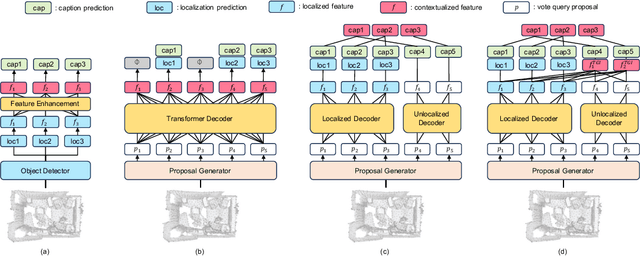
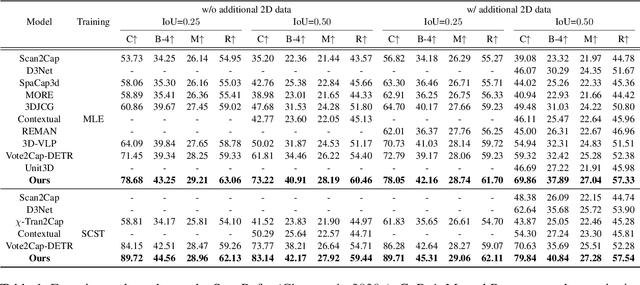
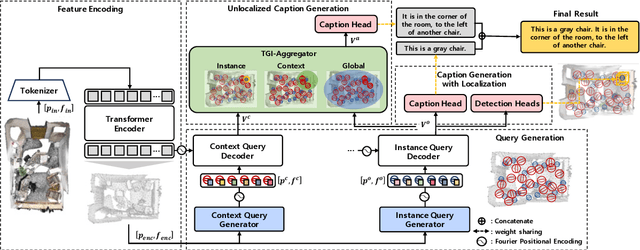
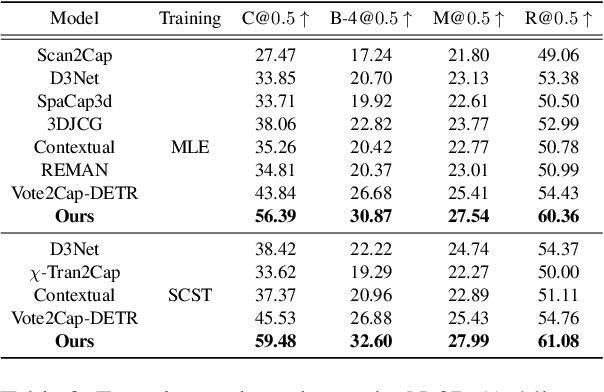
Abstract:3D dense captioning is a task to localize objects in a 3D scene and generate descriptive sentences for each object. Recent approaches in 3D dense captioning have adopted transformer encoder-decoder frameworks from object detection to build an end-to-end pipeline without hand-crafted components. However, these approaches struggle with contradicting objectives where a single query attention has to simultaneously view both the tightly localized object regions and contextual environment. To overcome this challenge, we introduce SIA (See-It-All), a transformer pipeline that engages in 3D dense captioning with a novel paradigm called late aggregation. SIA simultaneously decodes two sets of queries-context query and instance query. The instance query focuses on localization and object attribute descriptions, while the context query versatilely captures the region-of-interest of relationships between multiple objects or with the global scene, then aggregated afterwards (i.e., late aggregation) via simple distance-based measures. To further enhance the quality of contextualized caption generation, we design a novel aggregator to generate a fully informed caption based on the surrounding context, the global environment, and object instances. Extensive experiments on two of the most widely-used 3D dense captioning datasets demonstrate that our proposed method achieves a significant improvement over prior methods.
Bi-directional Contextual Attention for 3D Dense Captioning
Aug 13, 2024
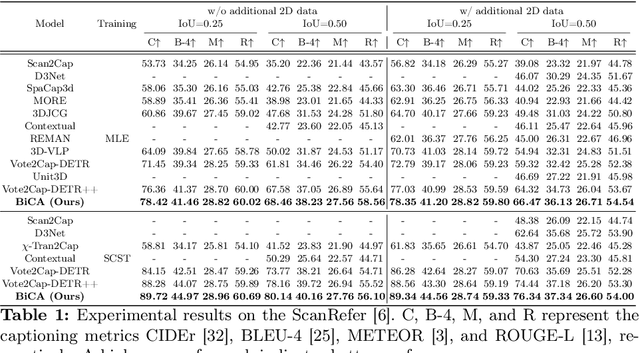
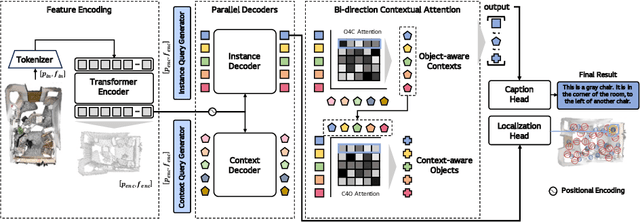
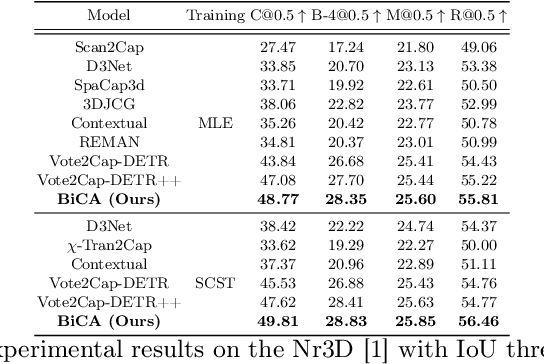
Abstract:3D dense captioning is a task involving the localization of objects and the generation of descriptions for each object in a 3D scene. Recent approaches have attempted to incorporate contextual information by modeling relationships with object pairs or aggregating the nearest neighbor features of an object. However, the contextual information constructed in these scenarios is limited in two aspects: first, objects have multiple positional relationships that exist across the entire global scene, not only near the object itself. Second, it faces with contradicting objectives--where localization and attribute descriptions are generated better with tight localization, while descriptions involving global positional relations are generated better with contextualized features of the global scene. To overcome this challenge, we introduce BiCA, a transformer encoder-decoder pipeline that engages in 3D dense captioning for each object with Bi-directional Contextual Attention. Leveraging parallelly decoded instance queries for objects and context queries for non-object contexts, BiCA generates object-aware contexts, where the contexts relevant to each object is summarized, and context-aware objects, where the objects relevant to the summarized object-aware contexts are aggregated. This extension relieves previous methods from the contradicting objectives, enhancing both localization performance and enabling the aggregation of contextual features throughout the global scene; thus improving caption generation performance simultaneously. Extensive experiments on two of the most widely-used 3D dense captioning datasets demonstrate that our proposed method achieves a significant improvement over prior methods.
FIMP: Future Interaction Modeling for Multi-Agent Motion Prediction
Jan 29, 2024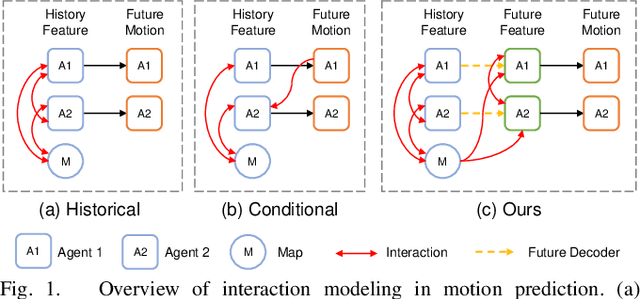
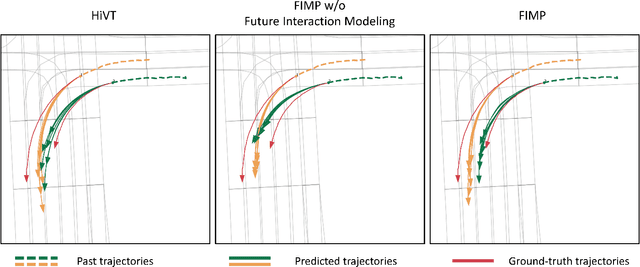

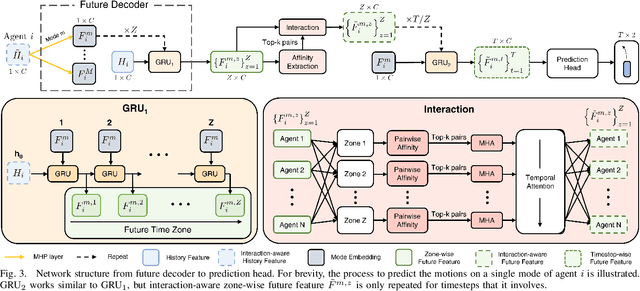
Abstract:Multi-agent motion prediction is a crucial concern in autonomous driving, yet it remains a challenge owing to the ambiguous intentions of dynamic agents and their intricate interactions. Existing studies have attempted to capture interactions between road entities by using the definite data in history timesteps, as future information is not available and involves high uncertainty. However, without sufficient guidance for capturing future states of interacting agents, they frequently produce unrealistic trajectory overlaps. In this work, we propose Future Interaction modeling for Motion Prediction (FIMP), which captures potential future interactions in an end-to-end manner. FIMP adopts a future decoder that implicitly extracts the potential future information in an intermediate feature-level, and identifies the interacting entity pairs through future affinity learning and top-k filtering strategy. Experiments show that our future interaction modeling improves the performance remarkably, leading to superior performance on the Argoverse motion forecasting benchmark.
EP2P-Loc: End-to-End 3D Point to 2D Pixel Localization for Large-Scale Visual Localization
Sep 14, 2023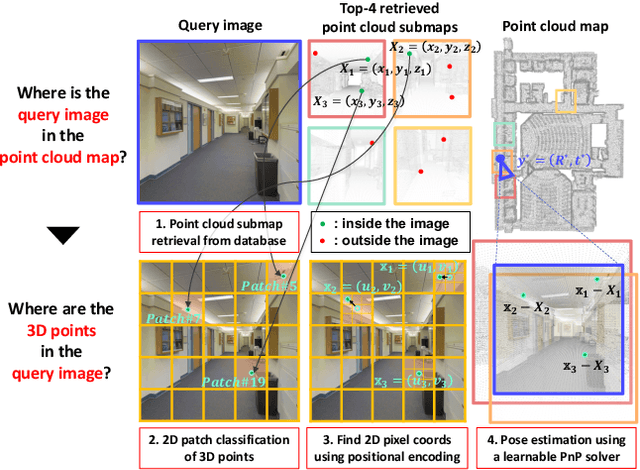
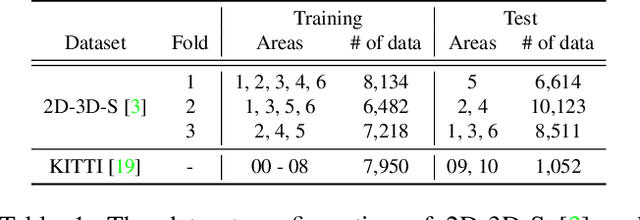
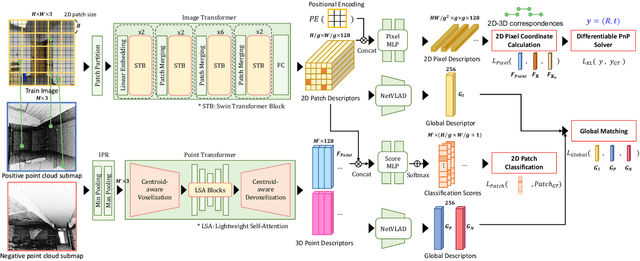

Abstract:Visual localization is the task of estimating a 6-DoF camera pose of a query image within a provided 3D reference map. Thanks to recent advances in various 3D sensors, 3D point clouds are becoming a more accurate and affordable option for building the reference map, but research to match the points of 3D point clouds with pixels in 2D images for visual localization remains challenging. Existing approaches that jointly learn 2D-3D feature matching suffer from low inliers due to representational differences between the two modalities, and the methods that bypass this problem into classification have an issue of poor refinement. In this work, we propose EP2P-Loc, a novel large-scale visual localization method that mitigates such appearance discrepancy and enables end-to-end training for pose estimation. To increase the number of inliers, we propose a simple algorithm to remove invisible 3D points in the image, and find all 2D-3D correspondences without keypoint detection. To reduce memory usage and search complexity, we take a coarse-to-fine approach where we extract patch-level features from 2D images, then perform 2D patch classification on each 3D point, and obtain the exact corresponding 2D pixel coordinates through positional encoding. Finally, for the first time in this task, we employ a differentiable PnP for end-to-end training. In the experiments on newly curated large-scale indoor and outdoor benchmarks based on 2D-3D-S and KITTI, we show that our method achieves the state-of-the-art performance compared to existing visual localization and image-to-point cloud registration methods.
MadSGM: Multivariate Anomaly Detection with Score-based Generative Models
Aug 29, 2023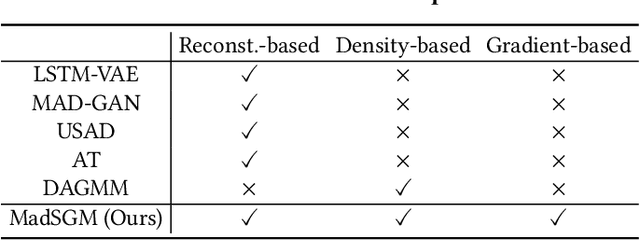


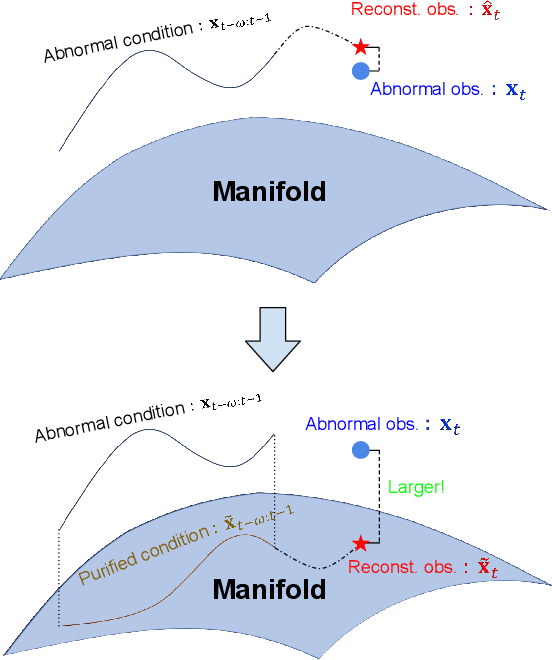
Abstract:The time-series anomaly detection is one of the most fundamental tasks for time-series. Unlike the time-series forecasting and classification, the time-series anomaly detection typically requires unsupervised (or self-supervised) training since collecting and labeling anomalous observations are difficult. In addition, most existing methods resort to limited forms of anomaly measurements and therefore, it is not clear whether they are optimal in all circumstances. To this end, we present a multivariate time-series anomaly detector based on score-based generative models, called MadSGM, which considers the broadest ever set of anomaly measurement factors: i) reconstruction-based, ii) density-based, and iii) gradient-based anomaly measurements. We also design a conditional score network and its denoising score matching loss for the time-series anomaly detection. Experiments on five real-world benchmark datasets illustrate that MadSGM achieves the most robust and accurate predictions.
Regular Time-series Generation using SGM
Jan 20, 2023
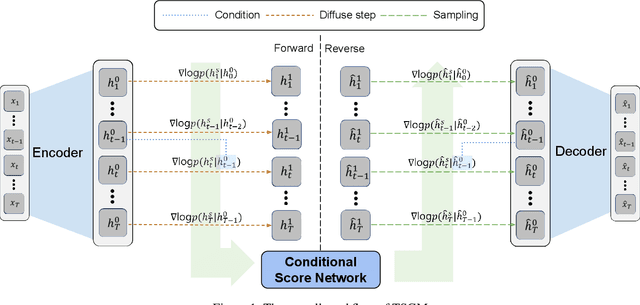
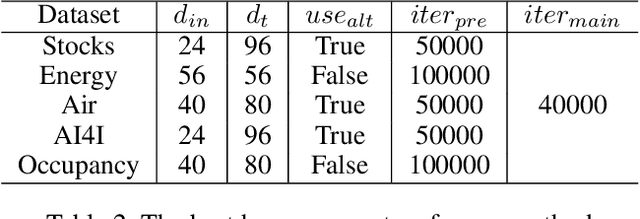
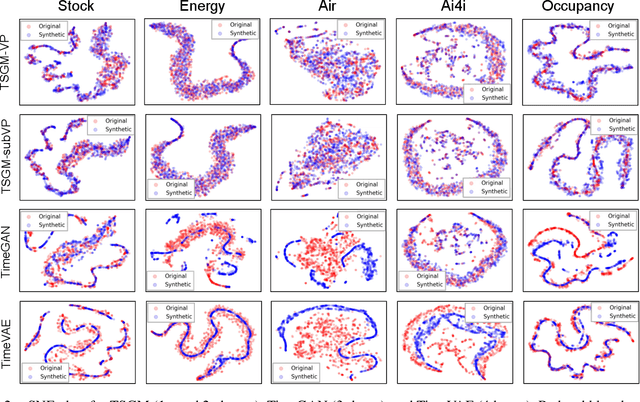
Abstract:Score-based generative models (SGMs) are generative models that are in the spotlight these days. Time-series frequently occurs in our daily life, e.g., stock data, climate data, and so on. Especially, time-series forecasting and classification are popular research topics in the field of machine learning. SGMs are also known for outperforming other generative models. As a result, we apply SGMs to synthesize time-series data by learning conditional score functions. We propose a conditional score network for the time-series generation domain. Furthermore, we also derive the loss function between the score matching and the denoising score matching in the time-series generation domain. Finally, we achieve state-of-the-art results on real-world datasets in terms of sampling diversity and quality.
Feature Disentanglement Learning with Switching and Aggregation for Video-based Person Re-Identification
Dec 16, 2022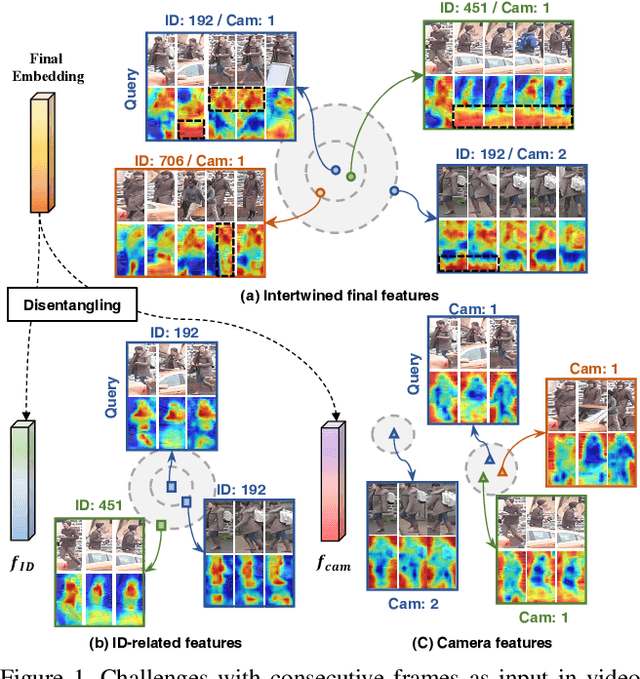
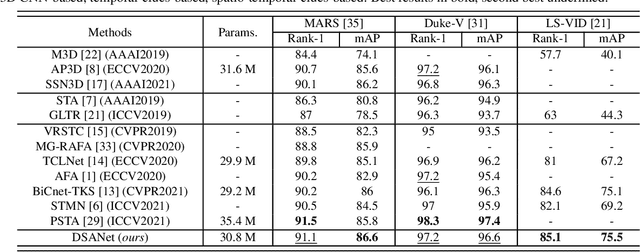
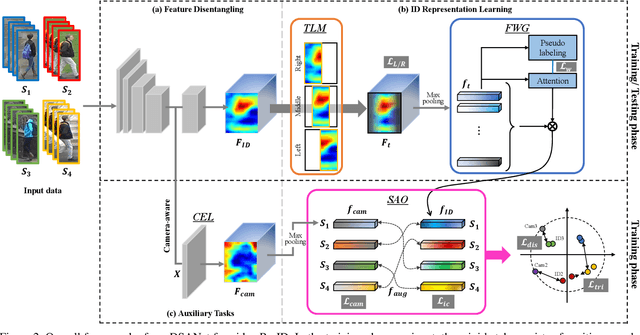
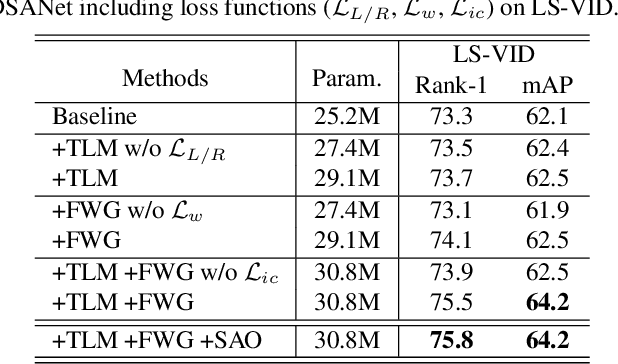
Abstract:In video person re-identification (Re-ID), the network must consistently extract features of the target person from successive frames. Existing methods tend to focus only on how to use temporal information, which often leads to networks being fooled by similar appearances and same backgrounds. In this paper, we propose a Disentanglement and Switching and Aggregation Network (DSANet), which segregates the features representing identity and features based on camera characteristics, and pays more attention to ID information. We also introduce an auxiliary task that utilizes a new pair of features created through switching and aggregation to increase the network's capability for various camera scenarios. Furthermore, we devise a Target Localization Module (TLM) that extracts robust features against a change in the position of the target according to the frame flow and a Frame Weight Generation (FWG) that reflects temporal information in the final representation. Various loss functions for disentanglement learning are designed so that each component of the network can cooperate while satisfactorily performing its own role. Quantitative and qualitative results from extensive experiments demonstrate the superiority of DSANet over state-of-the-art methods on three benchmark datasets.
Occluded Person Re-Identification via Relational Adaptive Feature Correction Learning
Dec 09, 2022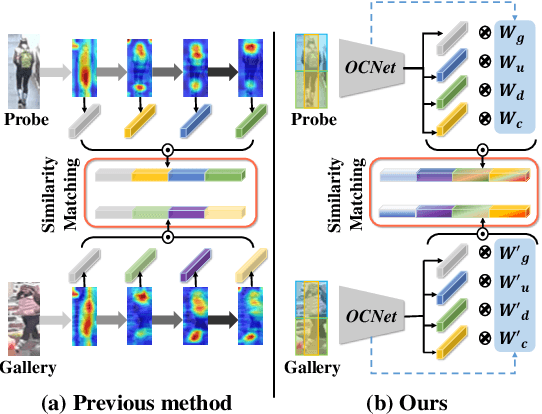



Abstract:Occluded person re-identification (Re-ID) in images captured by multiple cameras is challenging because the target person is occluded by pedestrians or objects, especially in crowded scenes. In addition to the processes performed during holistic person Re-ID, occluded person Re-ID involves the removal of obstacles and the detection of partially visible body parts. Most existing methods utilize the off-the-shelf pose or parsing networks as pseudo labels, which are prone to error. To address these issues, we propose a novel Occlusion Correction Network (OCNet) that corrects features through relational-weight learning and obtains diverse and representative features without using external networks. In addition, we present a simple concept of a center feature in order to provide an intuitive solution to pedestrian occlusion scenarios. Furthermore, we suggest the idea of Separation Loss (SL) for focusing on different parts between global features and part features. We conduct extensive experiments on five challenging benchmark datasets for occluded and holistic Re-ID tasks to demonstrate that our method achieves superior performance to state-of-the-art methods especially on occluded scene.
 Add to Chrome
Add to Chrome Add to Firefox
Add to Firefox Add to Edge
Add to Edge